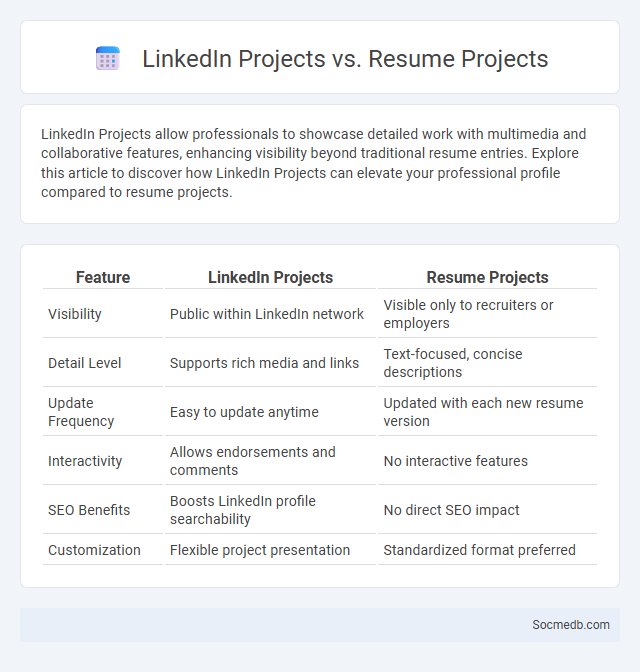
Photo illustration: LinkedIn Projects vs Resume Projects
LinkedIn Projects allow professionals to showcase detailed work with multimedia and collaborative features, enhancing visibility beyond traditional resume entries. Explore this article to discover how LinkedIn Projects can elevate your professional profile compared to resume projects.
Table of Comparison
| Feature | LinkedIn Projects | Resume Projects |
|---|---|---|
| Visibility | Public within LinkedIn network | Visible only to recruiters or employers |
| Detail Level | Supports rich media and links | Text-focused, concise descriptions |
| Update Frequency | Easy to update anytime | Updated with each new resume version |
| Interactivity | Allows endorsements and comments | No interactive features |
| SEO Benefits | Boosts LinkedIn profile searchability | No direct SEO impact |
| Customization | Flexible project presentation | Standardized format preferred |
Understanding LinkedIn Projects: Purpose and Impact
LinkedIn Projects serve as a strategic feature allowing professionals to showcase specific work experiences, skills, and accomplishments directly on their profiles, enhancing their credibility and visibility. Highlighting completed projects with detailed descriptions and multimedia evidence helps recruiters and peers assess expertise and real-world application of skills. This feature significantly impacts networking opportunities and career growth by providing concrete examples of professional capabilities and achievements.
Resume Projects: Showcasing Achievements Effectively
Highlighting your resume projects on social media platforms can significantly boost your professional visibility by showcasing tangible achievements and skills. Using targeted keywords and multimedia elements like images or videos enhances engagement and clearly demonstrates your expertise to potential employers. You can strategically leverage LinkedIn, Twitter, or specialized portfolio sites to attract recruiters and expand your professional network.
Key Differences Between LinkedIn and Resume Projects
LinkedIn showcases a dynamic, interactive portfolio of your professional journey, allowing endorsements, recommendations, and real-time updates that highlight your skills and achievements. Resume projects are concise, curated entries focused on specific accomplishments and results, crafted to fit targeted job applications and ATS requirements. Understanding these key differences helps you optimize your professional branding by leveraging LinkedIn's network-driven exposure alongside the precision of resume projects.
Selecting the Right Projects for LinkedIn vs Resume
Selecting the right projects for LinkedIn involves highlighting those with measurable impact, industry relevance, and updated skills that resonate with a broad professional network. Resume projects should be concise, tailored to the specific job description, and emphasize quantifiable achievements to pass Applicant Tracking Systems. Both platforms benefit from clear descriptions but require different emphasis: LinkedIn for networking and personal branding, resumes for targeted job applications.
Optimizing Project Descriptions for LinkedIn Visibility
Optimizing your project descriptions for LinkedIn visibility requires incorporating industry-specific keywords that align with your professional skills and goals. Use clear, concise language and highlight measurable achievements to attract recruiters and collaborators within your field. Tailoring your descriptions to showcase expertise and relevant tools enhances your profile's searchability and engagement.
Crafting Results-Oriented Resume Project Entries
Creating results-oriented resume project entries on social media involves highlighting quantifiable achievements, such as increased follower growth by 30% or improved engagement rates by 50%. Use action verbs like "developed," "optimized," and "launched" to convey impact effectively. Incorporate relevant metrics and social media tools (e.g., Hootsuite, Google Analytics) to demonstrate technical proficiency and measurable success.
Resume Optimization: Best Practices and Key Strategies
Optimizing your resume for social media platforms involves incorporating relevant keywords and industry-specific jargon to enhance visibility in applicant tracking systems and recruiter searches. Highlighting measurable achievements and quantifiable results tailored to the job description strengthens credibility and engagement with potential employers on LinkedIn and other professional networks. Utilizing a clean, keyword-rich format and updating your profile regularly ensures alignment with current social media algorithms and hiring trends.
Aligning Projects with Target Roles and Industries
Tailoring social media content to align with specific target roles and industries enhances engagement and relevance by addressing the unique needs and interests of the audience. Utilizing platforms favored by industry professionals, such as LinkedIn for corporate sectors or Instagram for creative fields, maximizes visibility and connection opportunities. Crafting project showcases with industry-specific keywords and case studies demonstrates expertise and attracts recruiters or clients within those sectors.
Common Mistakes in Project Listing and Optimization
Many users make common mistakes in social media project listings, such as poorly crafted headlines, vague descriptions, and lack of target keywords, which reduce visibility and engagement. Ignoring platform-specific algorithms and failing to optimize tags or categories can limit your project's reach and impact. Ensuring your content is clear, targeted, and strategically optimized enhances discoverability and drives meaningful interactions.
Actionable Tips for Enhancing Both LinkedIn and Resume Projects
Optimize LinkedIn profiles by incorporating industry-specific keywords and quantifiable achievements to improve searchability and employer appeal. Craft resumes with tailored action verbs and concise bullet points emphasizing measurable results, aligning with LinkedIn summaries for consistency. Integrate multimedia elements such as project presentations or endorsements on LinkedIn to reinforce skills highlighted in resumes and boost professional credibility.
 socmedb.com
socmedb.com